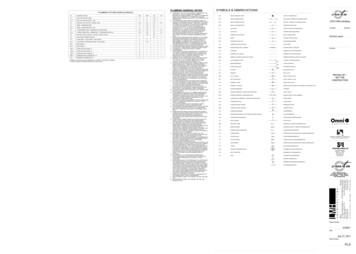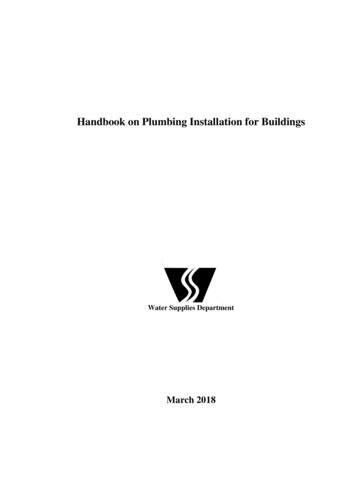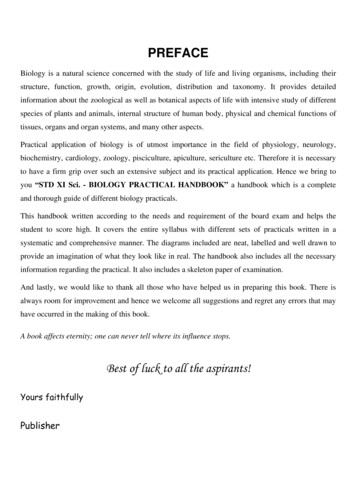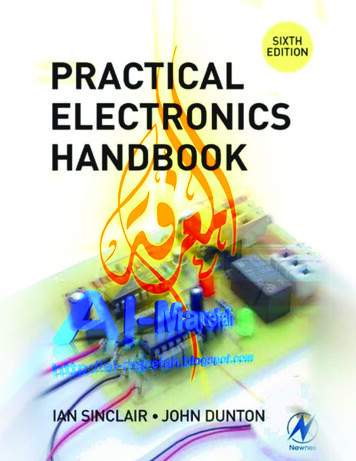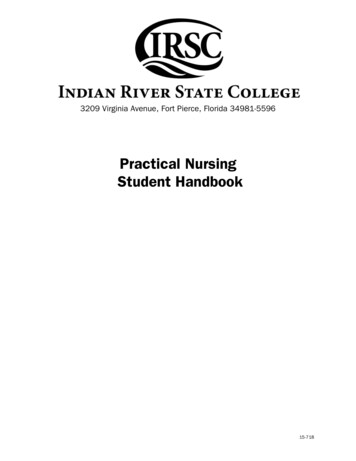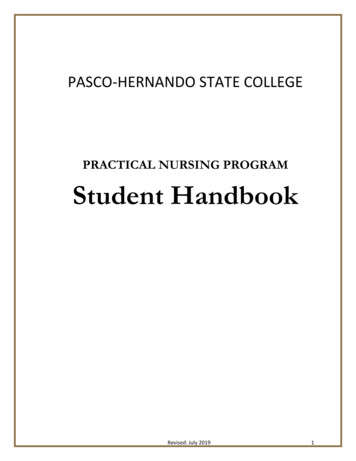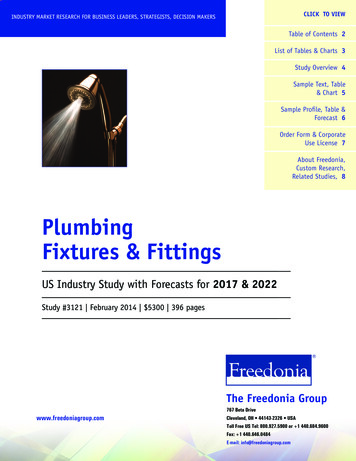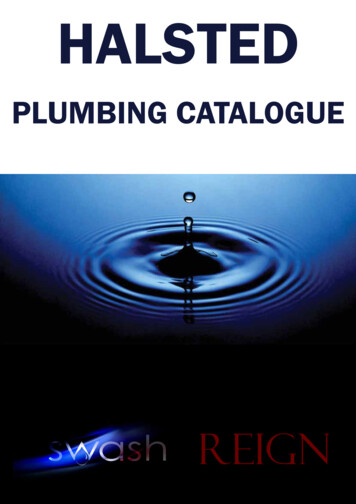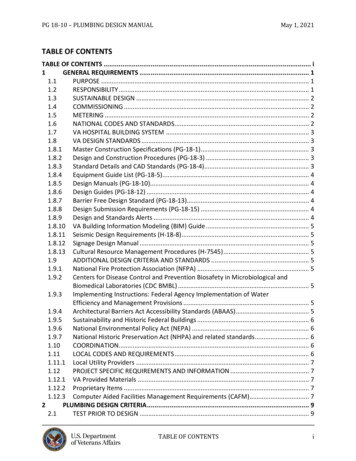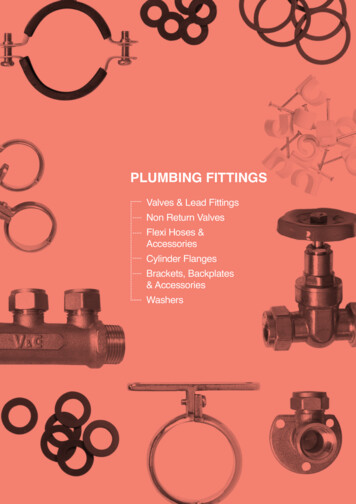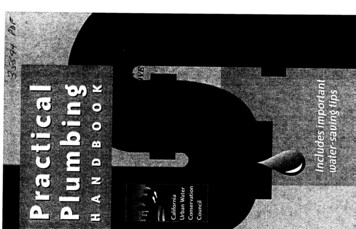
Transcription
1. The ABCs of Plumbihg.Water MetersMaster ValvesShutoffvalves .5Water Pressure .5Frozen Pipes6Preventing Frozen Pipes .U7Water Hammers .8Leaks .10Leaky Supply Tubing .10Hot Water-Leaks from ValvesLow Pressure .High Pressure .Faucets11122. Preventive MaintenanceAerators .19Clothes Washers .20Dishwashers21Hot Water Demand Recirculation Systems . 2 2PTessure Regulators .Refrigerators .Reverse Osmosis Units .24Toilets: Tune-up Tips .26Types of Toilets26Toilet Parts .27Toilet Troubleshooting .33Water Heaters .Water SoftenersWater Treatment Units42. 4445
\3. Resources’ GuidedBooks. 47Website InformationDo-It-Yourself Information . 47Energy Information .47Plumbing Information . .48Plumbing Codes and Standards .48Toilet Information . .48
Funny, It Didn’t Look BrokenIWater MetersI“Meter, meter wherefore art thou?”Your water meter keeps track of how much water yourhousehold uses. The meter is usually located alongthe sidewalk, in front of your home, inside a concretebox with a concrete cover marked “WATER METER.” .In some homes the water meter is located in thebasement. It may be a bit dark inside th4meter box,so bring a flashlight along!01811171110The two commonmeter typesMeters measure water either in cubic feet or gallons.One cubic foot equals 7.48 gallons. For example, ifyour meter says you used 41 cubic feet in a day, youwould multiply 41 by 7.48 to find out that over 306gallons were used that day. Utilities with meters bill bythe “unit,” normally, such units are measured as 100cubic feet (748 gallons) or alternatively, 1,000 gallons.You can check for leaks on individually meteredresidences by using your meter. Make certain that nowater is being used on the property. Then open thecap of your water meter. Note the location of the dialtest hand. Don’t run water for 30 minutes. If the dialhas moved, you’ve got a leak. Read on to determinethe possible cause.Mast e r Va lvesA master water supply valve controls the water supplycoming into your home. Every home has a mastervalve that is most likely located near the water meteror where the water supply pipe enters your home.
Once you have found the master valve, paint or label itso it is easy to locate. Let everyone in the home knowwhere to find the valve in case of an emergency. Makesure the master valve is accessible; if a pipe is brokenand water is gushing out, you don't want to be climbing over a pile of boxes to be able to shut off the valve!'To shut off the water supply to your home, slowly turnthe handle counter-clockwise.To turn your water backon, just reverse the above steps. Be certain to cover themeter box when you are finished. It's a good idea toplace a few drops of oil around the handle, once a yearor so, to prevent the valve from sticking or corroding.iShutoff Valves - aka" Angle Stops"Most modern homes also have shutoff valves for thelines to individual fixtures. Shutoffs are under sinks onboth hot and cold supply lines; just inside the housefrom an outdoor faucet; beneath a toilet tank; wherehoses lead to a clothes washer; at the pipe leading intoa water heater; or just upstream from bathtub faucets.Check these valves annually to ensure they are notstuck in place or corroded. If other fixtures have waterand dparticular one does not, it is most likely theshutoff valve just upstream, which may be wholly orpartially turned off If no water is coming from a hotwater faucet and the angle stop is on, the inlet or outletvalve on the water heater is probably turned off.Water PressureEven your pipes can get stressed!Water should enter the house at about 45 to 60pounds per square inch (psi).You can check your waterpressure with a water pressure gauge. The gauge screwsto a hose bibb. Water pressure over 60 psi can causea strain on your plumbing fixtures or pipes and evencause bursts in the water line.The ABCs ofPlumbing 5
.Possible causes of low or no water pressure:0Bad diverter valve for a spray nozzle0'Clogged water filter attached to a faucetClogged strainers just inside hose connectionsClogged showerheadFrozen or freezing pipesFaucet aerators often clog after work has been done onsupply pipes because repair work often looSens rustinside the pipes. If you suspect a build up of sedimentin a supply pipe, turn off the water supply, remove theangle stop and peer down the supply pipe. If the pipeis clogged, clear it with a snake. Reattach the anglestop. Turn on the 'water supply and, with a bucket tocatch water, flush out the pipes before reattaching thevalve to the supply tube.Frozen PipesBlocked or restricted water flow is the first indicationof a problem. If you don't act quickly your pipes willburst as the water expands. At the first sign of a blockage, open the faucet. Finding the blockage is critical.Trace the supply pipe to where it runs throughexterior walls or other unheated parts of ybur house,such as the basement or crawl space.To melt the ice,use hot water, a heat gun, hair dryer or heating pad.It is far better to adopt the slower and more conservative procedure 'of melting ice by the use of a blowdryer or heat gun.Shield flammable materials from the heat. Whileapplying heat, leave the faucet open so water can drain.Once the ice melts and the pipes cool, prevent themfrom refreezing by jacketing them with foam insulation. Wrap all pipes that pass through unheated spaces.Pipes buried outdoors should run about 12 inches .below the frost line and should be wrapped with foaminsulation extending below frost line.If you expect a freeze, leave exposed taps dripping toprevent frozen pipes.I16 TheABCs offlumbinq
Preventing Frozen PipesWater pipes that are exposed to freezing temperatures ordrafts should be covered with insulation. When pipesare laid underground they should be below the frostline to prevent freezing. Small water pipes vtifl freezequicker than waste or sewer pipes.If there is plumbing in the garage, do not leave thegarage door open during severely cold weather. The coldand draft can freeze water lines in minutes. Pipes locatedin unheated basements or garages should be insulatedwith a commercial covering.Before the cold freezing weather sets in, disconnect allgarden hoses outside your home; otherwise the hoseand hose bib may freeze and be damaged. This is especially important with anti-freeze hydrants. If tbe hose isdisconnected, the anti-freeze faucet can properly drain,and this will prevent freezing.I4If your home is going to be unattended for a longperiod of time during cold weather and the heatingsystem is turned off, follow the following precations:Shut off the water supply at the master valve.BeginniDg with fixtures on thetop floor, open allfaucets and leave them open. When water stopsrunning from these faucets, open the cap on themain shutoff valve and drain the remaining waterinto a pail or tub.Remember to close the cap after the faucets haverud dry. Otherwise the house water supply will flowfrom this valve and flood the basement.Remove all water in the traps under sinks, toilets,bathtubs, and lavatories by opening the clean outplugs at the bottom of traps and draining them intoa pail. If no plugs are provided, use a force pump orother method to siphon the water out.Sponge all the water out of the toilet bowl.Clean out all water in the flush tank.Fill all traps with a non-freezing solution such asmineral oil, windshield washmg fluid or RV typeanti-freeze.The ABCs ofPlumbing 7
0Drain all hot water tanks. Most tanks are equippedwith a vented tube at the top, which lets air inand allows the water to drain out the faucet atthe bottom.0Make sure all horizontal pipes drain properly. Airpressure will get rid of trapped water in thesepipes, but occasionally the piping may have to bedisconnected and drained. To be safe, have yourplumber check your entire plumbing system.0If your house is heated by hot water or steam,drain the heating pipes and boiler before leaving.0Burners and pilots should be completely out andthe main water supply turned off.0Drain off the water from the boiler by openingthe draw-off valve at the lowest point in thesystem. Open the water supply valve to the boilerso no water will be trapped above it.0If you have a hot water system, begin with thehighest radiators and open the air valve on eachas fast as the water lowers. Every radiator valvemust be opened on a 1 -inch pipe system torelease candensation.Water HammersEver hear a slamming or banging noise in your, waterpipes when someone shuts off a faucet?That soundis called a water hammer. It is caused by the suddenchange of water flow, with resulting pressure surges,which makes pipes vibrate.i8 TheABCs ofPlumbing1Over time, recurring water hammers can loosen themounting brackets that attach the pipes to the studsand joists in your home, leading to more movementand risk of leakage in joints and fittings. It can evencause a poorly soldered joint or fitting to completelybreak! To minimize water hammers, secure pipes toprevent @ovement and reduce sudden pressurevariations.Various devices are available that reducethe abrupt changes in water pressure.
leaks:through an .openingpressure 60 Ibs. 't,.Leaks: drops60 drops per minute 192 gallons per month90 drops per minute 310gallons per mbnth120 drops per minute 429 gallons per month2,190 gallons per month3,290 gallons per monthLeaks: smooth streams1,095 gallons per monthwTheABCs ofPlumbinq 9
LeaksALeaks should be fixed immediately since they can,quickly develop into a serious break. Temporaryrepairs are only temporary, and wrapping the pipeusually fails. If you find a fixture that is leaking, turnoff the shutoff valve for that device. Then locate theleak. Try to tighten any fittings that leak. A quarter orhalf turn with a wrench might do the trick. Be carefulnot to over-tighten fittings. Another possible,causeis that the pipes are undersized and the water velocityis too high.I leaky Supply TubingWhen the line, or tubing, that supplies water to afaucet or toilet leaks, it’s best to go ahead and replacethe tubing.Note: Make sure to get the right size fittings for each end ofthe tubing. The difference between one size/typeand another is subtle. Take your old supply tube/fittings with you and ask a clerk to select a properlength replacement with compatible fittings.Be prepared to replace the shutoff valve as well as thetubing. Old valves that no one has turned for yearsmay spring a leak when suddenly turned. First, you’llhave to shut off the main valve to ,your house. Thenuse a wrench or pliers to unscrew the old valve fromthe nipple in the wall. Place a bucket under the pipeand have someone turn the water on briefly to flushrust from the pipe. If the old nipple is damaged andrecessed too far in the wall to get a pipe wrench on it,try an internal pipe wrench to save your plaster.Buy a replacement valve with female thread to screw ‘onto the nipple. Wrap ,he nipple with Teflon tape, andthen screw on the new valve with an adjustablewrench. Be sure to point the valve outlet toward thefixture as you finish the last turn. Turn the main valveback on and test for leaks.
Hot Water-Leaks from Valves4If the water heater leaks from the drain valve, firsttighten the valve. If that fails, you can install a brasshose cap with a hose washer inside. If you tighten thehose cap with pliers, it will stand up to typical waterpressure. Check the current pressure with a waterpressure gauge. If the reading is between 45 and 60psi, the problem is probably the relief valve.Turn offwater supply and the electricity or gas to the waterheater. Partially drain the tank. If there is an overflowpipe, remove it. Unscrew the relief valve, and screw ina new one.Low PressureMake sure all the valves are wide open. There couldbe blockage in the faucet or in the supply line to theoff the hot water angle stop, thenhot water side. Turn,'get a basin wrench and loosen the supply line whereit meets the faucet.Then get a bucket and hold thesupply line in it while turning on the angle stop. Ifyou have good pressure there, then the blockage isin the faucet.If you determine that it's in the faucet then: If it is thetype that has a cartridge, change the cartridge. If it isthe kind with stems, remove e hot water stem andcheck for particles qr damage. rf the faucet is the oldwasher style it will need to be disassembled, cleaned,oiled and rebuilt-If it's a newer style with cartridgesor a ball valve, then the cartridge or ball and assortedseals will need to be replaced.IHiqh PressureIf your water pressure is high, installing a regulatorand hot water expansion tank will allow excessivewater pressure to expand back to the main water linewhen the pressure exceeds the incoming water pres'sure. These devices will help reduce wear and tear onpipes and the risk of a pipe or supply tube bursting.The ABCsofPlombing 11I
FaucetsFaucets typically leak because of old gaskets or O-ringsand corroded valve seats. The single most commonmistake in faucet repair is not taking along the faucet/parts when buying the replacement parts.Before working on any faucet turn the water off andopen the lines to drain the water out. Cover the sinkwith a towel to protect it from tools that might dropand to preven
If there is plumbing in the garage, do not leave the garage door open during severely cold weather. The cold and draft can freeze water lines in minutes. Pipes located in unheated basements or garages should be insulated with a commercial covering. Before the cold freezing weather sets in, disconnect all garden hoses outside your home; otherwise the hose and hose bib may freeze and be damaged .
